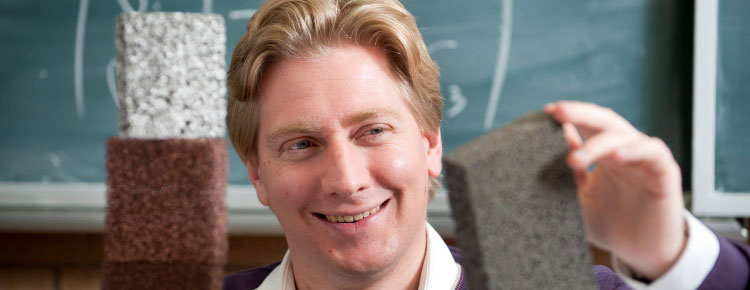Researcher Highlights
Foam and function
Associate Professor Thomas Fiedler
Associate Professor Thomas Fiedler is driving the development of new-generation cellular materials that are light, strong and multi-functional.

To the untrained eye, the metal sample blocks in Associate Professor Thomas Fiedler's office look almost fragile, with their unusual, porous configurations. But looks can be deceiving, and these metallic structures are, in fact, incredibly strong and versatile materials with potential for widespread industrial application.
The blocks are examples of what are known as cellular materials, which are manufactured by introducing a foaming solution to molten metal that gives the end product an aerated appearance. The materials produced from this and similar techniques are both strong and lightweight, have thermal-insulating and acoustic-dampening properties and can absorb high amounts of energy from an impact – all of which makes them prospectively well-suited to purposes such as car and aircraft manufacturing.
German-born Fiedler has been involved in research and development of cellular materials at the University of Newcastle since moving to the city in 2008 to take up a postdoctoral appointment within the Centre for Geotechnical and Materials Modelling. "This is still largely a development area in terms of research but these materials have great potential and some are already being used in commercial applications, such as luxury motor vehicles," Fiedler explains. "Scientists in the field are working on improving the reliability and consistency of the materials and experimenting with ways to produce them more cost-effectively."
Fiedler is investigating another use for metal foams as part of an Australian Research Council Postdoctoral Fellowship project developing alternative cooling systems for buildings, electronic devices and other applications. The project centres on the design of next-generation 'heat sinks', materials that can be used to absorb heat in place of electrically powered devices. To illustrate their use, Fiedler uses the example of laptop computers, which rely mostly on small, built-in cooling devices to ensure they do not overheat.
"A built-in fan will cool the computer down, but you then need extra power to run the fan, and it adds size to the device," he points out. "A heat sink will absorb and store that heat without adding substantial bulk or requiring additional energy."
Paraffin is recognised as an effective heat sink because it is a phase-change material (PCM) capable of absorbing a substantial amount of heat at the point at which it transforms from solid to liquid form. However, it has poor thermal conductivity, so Fiedler is blending paraffins with cellular metals – such as copper foams – to create prototype composite materials that work more effectively as heat sinks by combining the optimum properties of both.
"A typical application could be solar heating and cooling, where you could use the material to absorb thermal energy during the day then release that heat later to warm buildings or water systems," Fiedler explains. "These composite heat sinks provide a largely untapped solution for energy-efficient temperature control and emission-free heating."
Fiedler's research encompasses both experimental work and the development of high-level computational techniques for modelling new material combinations. He uses the Lattice Monte Carlo Method, a powerful and computationally demanding algorithmic modelling tool. Fiedler has forged collaborations with research groups in Malaysia, Portugal, Slovenia, Brazil and Germany and his work in the development of cellular metals has attracted interest from prospective commercial partners.
"The University of Newcastle produces first-class research in this field," he says. "We have a lot of expertise in our group, access to powerful computers, and collaborations with influential partners around the world – all of which contributes to our strong international reputation."
A new body of work
The development of biologically friendly surgical implants might seem a long way removed from the design of composite metals used in industrial applications, but Dr Thomas Fielder's wide-ranging research spans both fields.
"The connection is that they are both cellular materials," he outlines. "The biomaterials I am working on have a similar structure to the metallic foams I study so I am able to apply my skills in manipulating the properties of cellular materials."
Fiedler is involved in a collaboration with Professor Aldo Boccaccini, a leading biomaterials researcher from the University of Erlangen-Nuremberg, in Germany. Together they are developing surgical implants and devices (scaffolds) that help repair defects in tissue, skin and bones, then dissolve in the body, negating the need for follow-up surgery to remove them.
"Biomaterials have been used for some time, but we are developing third-generation designs, which are both bioactive and able to slowly dissolve," Fiedler states. "I am looking at the construction of the materials, investigating the mechanical properties and experimenting with things like titanium reinforcement to make them stronger."
The collaboration represents a new direction for Fiedler's research and one that he believes perfectly illustrates the vast potential of cellular materials in seemingly disparate disciplines. "Ironically," he adds, "the construction of cellular metals is inspired by bone structure, so applying my research back to the body is, in a way, completing the circle."
Visit the Centre for Geotechnical and Materials Modelling website
The University of Newcastle acknowledges the traditional custodians of the lands within our footprint areas: Awabakal, Darkinjung, Biripai, Worimi, Wonnarua, and Eora Nations. We also pay respect to the wisdom of our Elders past and present.
